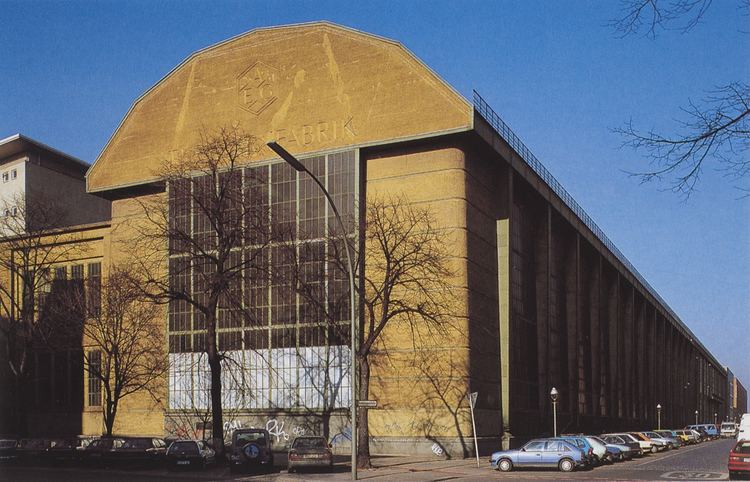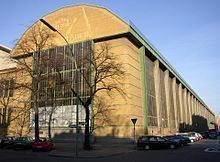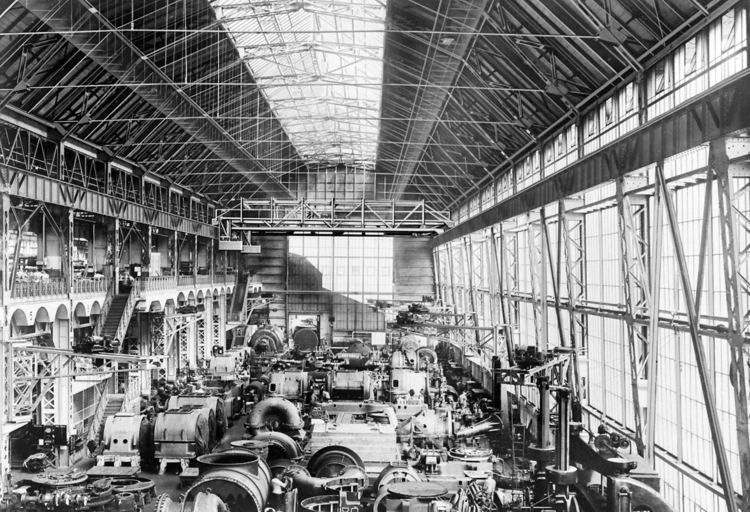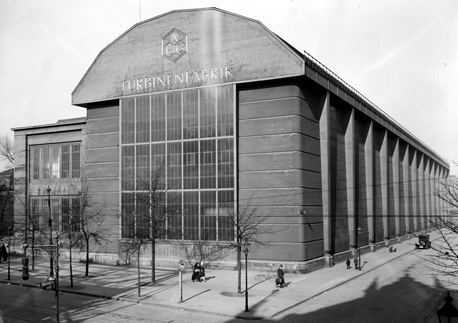Opened 1909 | ||
 | ||
Similar Fagus Factory, Werkbund Exhibition, Steiner House, Glass Pavilion, Einstein Tower | ||
aeg turbine factory
The AEG turbine factory was built around 1909, at Huttenstraße 12-16 in the Berlin district of Moabit. It is the best known work of architect Peter Behrens. It is an influential and well-known example of industrial architecture. Its revolutionary design features 100m long and 15m tall glass and steel walls on either side. It was a bold move and world first that would have a durable impact on architecture as a whole.
Contents
Origin
The site was since 1892, occupied by the electrical company founded by August Thyssen and the Thomson Houston Electric Company, the Union-Elektricitäts-Gesellschaft (UEG). The company's goal was to get into the booming electrical industry, and this site was dedicated to the production of electric trams. But the company quickly encountered financial difficulties, and the Allgemeine Elektricitäts-Gesellschaft (AEG) took over in 1904 and planned the construction of a new turbine factory, as the existing factory had become too small.

The architect Peter Behrens was commissioned with the construction of the new building. More than an architect, Behrens was employed from 1907 by AEG as an artistic consultant and designed the company logo, and other company graphics for the building. He was also in charge of the overall image of the company. Initially influenced by the developing Art Nouveau, the architect turned soon to the Werkbund, which in turn was influenced by the British Arts and Crafts.
Construction

The turbine hall was built in 1909 under Peter Behrens as lead architect and engineer Karl Bernhard at the corner of Huttenstraße and Berlichingenstraße streets in Berlin-Moabit. The building mainly consists of steel components, glass, and traditional Greek and Egyptian temples. The original building measures 25.6 m + 12.5 m in width, a height of 25 m and a length of 123 m. Behrens' design provided a neo-classical look to the industrial building, with weighty (but non-functional) gable ends and trabeated 'columns' to either side. David Watkin describes it as a "temple of power". Similarly, Tom Wilkinson likens it to an "up-to-date edition of the Parthenon".

In 1939, Jacob Schallberger and Paul Schmidt designed an extension of the hall to the north. The whole building was developed to function as a production site for turbines. It is now part of Siemens, which still operates a gas turbine plant there. This factory was actually designed with such foresight that it still serves the same purpose of producing turbines, a hundred years later.

The other factories that AEG had at that time, mostly known as "crenellated castle-cities", were places where technology occurred in a dowdy coat of historicist design. Among the requirements and expectations of the AEG was the intent to design an impressive and sophisticated, large scale construction. Peter Behrens created an architecture for the industry that came out of the clamp of hiding behind historic facades and transformed itself into a new self-confidence.
The building has been classified since 1956 as a protected historical monument, and underwent a restoration in 1978. On the south side there is a plaque with information about the construction, architects, and heritage status.
